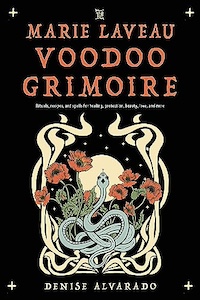
The Marie Laveau Voodoo Grimoire: Rituals, Recipes, and Spells for Healing, Protection, Beauty, Love, and More, Denise Alvarado
Weiser Books, 1578638135, 240 Pages, February 2024
When I went on a witchy pilgrimage to New Orleans in September 2019, the highlight of my trip was a guided tour through Saint Louis Cemetery No. 1 to visit the legendary tomb of Voodoo Queen Marie Laveau. A heat wave was blazing through the South, and it was in the upper nineties that day. The long walk through the sweltering maze of mausoleums felt like a fever dream, and the marble tombs were blinding white in the blistering sun.
Some of the tombs cast merciful shade, and I was relieved to finally arrive at Laveau’s mausoleum towards the end of the tour without having a heat stroke. Rose quartz crystals, pennies, bobby pins, and hair ties were strewn at the base of the tomb as offerings to her spirit. The hair accessories may seem like strange offerings, but they pay homage to her occupation as a hairdresser. The tour guide said that even though this practice is prohibited, and the offerings are swept away daily, people continue to leave them anyway.1
Having had this memorable glimpse into the cult of the Voodoo Queen, I was excited to read The Marie Laveau Voodoo Grimoire by New Orleans native and rootworker Denise Alvarado. She has written over twenty books on Southern folk magic traditions, including The Magic of Marie Laveau (2020), Witch Queens, Voodoo Spirits, and Hoodoo Saints (2022), Voodoo Hoodoo Spellbook (2011), and The Voodoo Doll Spellbook (2014). She offers courses on Marie Laveau and New Orleans Voudou at Crossroads University.
In the introduction to The Marie Laveau Voodoo Grimoire, Alvarado gives a brief summary of the origins and permutations of Voodoo, from its roots in West African Vodun to the tourist voodoo of modern day Louisiana, and an intriguing biographical sketch of the Voodoo Queen of New Orleans. Marie Catherine Laveau (1801-1881) was born a free Creole woman of color in New Orleans on September 10, 1801.2 She is well known for commercializing Voudou and Hoodoo, making these illegal magical folk practices profitable and more palatable for public consumption.
“New Orleans Voudou and Hoodoo are closely related,” Alvarado says. “In Marie Laveau’s day, the two traditions were essentially one and the same…Each tradition is a resistance response to the harsh realities of slavery and the oppression experienced following emancipation.”3
I first became interested in Hoodoo during a time in my life when I felt forced to conceal my identity as a witch, so I was researching magical practices that could be performed under the guise of Christianity. Even now I still feel a need to be discreet and keep my practices indoors so I don’t attract negative attention from nosy neighbors. I think a lot of people today take for granted religious freedom, but there is still a lot of stigma around practicing any form of magic.
Even though Voudou is deeply woven into the fabric of New Orleans culture, Alvarado points out that it was illegal during Marie Laveau’s time and is still illegal today, even though the law against it is rarely enforced.4 She suspects that many practitioners “prefer to stay out of the public eye due to the stigma attached to Voudou and the safety issues that can arise when a person is known to be a Voudouist.”5 Alvarado’s historical reflections deepened my admiration for the resilience and adaptability of the Voudou faith, and Marie Laveau’s courage and audacity in openly practicing and commercializing Voudou.
Her rowdy rituals drew a lot of attention, but Laveau wasn’t just a mysterious Voodoo priestess. Alvarado paints an intriguing and complex portrait of her as a multifaceted human being with snippets of biographical information dispersed throughout the text “She is most loved and remembered by New Orleanians for her charity work, prison ministry, and services to the community,” Alvarado says. “Nonetheless, she was often targeted and harassed by the police,” but she had enough power and influence to avoid incarceration.6
She was a complicated character, who was both a philanthropist and a blackmailer, who collected gossip about wealthy patrons she overheard in her beauty parlor. Along with biographical notes from the author, each chapter is headed with quotes extracted from witness interviews compiled by the Federal Writers’ Project between 1936 and 1941, in which people who knew her as children shared their fond memories of her.7
Madame Laveau was allegedly illiterate, so this grimoire is Alvarado’s imagining of what the Voodoo Queen’s grimoire may have looked like had she been able to write one. She draws inspiration from authentic recipes and formulas commonly used during Laveau’s lifetime, as well as information passed down through the oral tradition, historical documents, and recipes from her own personal grimoires. “In addition to a strong background in New Orleans Voudou, Hoodoo, and Spiritualism, my Catholic Creole culture of origin helped immensely when writing this book,” Alvarado says. “Marie Laveau was a Louisiana Creole and Catholic also, and her spiritual practices reflect that.”8
Alvarado calls this blending of Catholicism with service to Marie Laveau the “Laveau Voudou tradition,”9 and she uses the spelling “Voudou” in accordance with the nineteenth- and twentieth-century sources that informed her research. “Marie Laveau’s Voudou is a folk religion resulting from her intentional blending of Catholicism and Voudou,” Alvarado says. “She openly practiced both religions without conflict and confusion.”10 It is not necessary to be initiated into this tradition in order to perform the workings presented in this grimoire. They are accessible to anyone and this book also contains “tips and advice for living a magickal, spiritual lifestyle.”11
For readers who may be wary of Voodoo practices due to the negative connotations associated with them, Alvarado provides reassurance:
“This grimoire is designed to only unleash blessings and magickal mysteries, to provide instructions for protection and defense, and to unlock joy and abundance for anyone reading it,” Alvarado says. “There is no danger here.”12
In Chapter 1, titled “Materia Magica,” she shares “the essential tools of the trade to be an effective conjure worker in the Laveau Voudou tradition.”13 “If you are working within a strict budget, the only tools you really need are yourself, a white candle, a glass of water, and the ability to focus your intention and utter words of power,”14 she says. I found the table of “Kitchen witch essentials,”15 which lists the magical properties of herbs and common household supplies, and the table of “Perfumes and colognes and their magical uses”16 to be helpful resources. I was acquainted with popular formulas like Florida Water, Peace Water, Rose Water, and Hoyt’s Cologne, but many of the magical perfumes and scented waters on this list were unfamiliar to me and I’m eager to try them out.
In honor of Marie Laveau’s work as a hairdresser and beautician, Chapter 2 covers “Beauty Formulas,” such as vintage perfumed dusting powders, hair treatments, and skincare. The hair treatments are simple, involving common kitchen ingredients like bananas, eggs, and olive oil. The powders appealed to me the most, and I’m thinking about trying the “Lavender Dust” scented body powder recipe.
“Even today, people who serve Marie Laveau offer her beauty-related items such as combs, mirrors, makeup, brushes, and perfumes in hopes that she will grant them favors,” Alvarado says.17 This reminds me of the coins, crystals, and bobby pins littering her tomb, and reveals the magical intention behind leaving them.
I love to cook, and I was delighted to discover that this book includes Creole recipes! In Chapter 5, titled “Conjure in the Kitchen,” Creole dishes are listed that can be prepared as offerings for Marie Laveau and other Voudou spirits, ancestral spirits, or just enjoyed as delicious and authentic New Orleans meals. I learned that the Holy Trinity of Creole cuisine is onion, bell pepper, and celery, and onions have a variety of magical uses, depending on their color. “Onions are associated with good luck—particularly red onions—while green onions bring good luck in finances, and white onions are a curative,” Alvarado says.18
I’m really into resin incenses lately, so the chapter on crafting incense blends was one of my favorites. It has recipes for several popular formulas, such as “Cleo May”, “Crown of Success”, “Fiery Wall of Protection”, and “Louisiana Van Van.” The recipes only have three or four ingredients, and measurements are not given, so the reader is instructed to use their intuition when creating the incense blends. “Altar Incense,” for example, only requires frankincense, myrrh, and cinnamon, all of which I already had on hand.19
In a section titled “Hoodoo’s Shells and Stones,” Alvarado discusses the magic of natural objects, such as cowry shells, coral, and lodestones. I already work with a pet lodestone that I gave a secret name and regularly feed magnetic sand and whiskey. She currently resides on my bookshelf, attracting more books than I have time to read! I was most interested in brain coral, which I had never heard of before. “Place a piece of brain coral on your altar for Crown of Success and King Solomon Wisdom works,”20 Alvarado says. Being a Mercury-ruled Gemini, this really appealed to me, and I plan on adding a brain coral to my Hermes altar in the future.
Alvarado’s passion for her craft and devotion to Marie Laveau shines through in her writing. This spellbinding grimoire captivated me from cover to cover and has been a real blessing to my personal practice, revitalizing my love of whipping up magical recipes and inspiring me to experiment with new blends and craft my own unique formulas. With lucid prose and simple, yet potent recipes, Alvarado makes Laveau Voudou accessible to anyone, regardless of their level of experience.

Rachel Christina McConnell is a witch, tarot reader, intuitive astrologer, and writing spider. She holds an MFA in Fiction from Columbia University in the City of New York. Her short stories have appeared in Dark Moon Lilith Press and Minerva Rising Press’s The Keeping Room. Links to her publications are available here: https://rachelchristinamcconnell.wordpress.com
